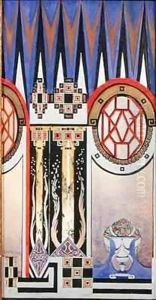Oliver Percy Bernard Paintings
Oliver Percy Bernard was a British architect, set designer, and painter, primarily recognized for his work in the field of set design for opera and ballet. Born on 26 June 1881 in Camberwell, London, Bernard was not only involved in architectural pursuits but also had an illustrious career in theatre that spanned across design and production.
Bernard's early life and education are not extensively documented, but it is known that he began his career as an architect. His interest in theatre design emerged later. He served in the Royal Engineers during World War I and his experiences during the war may have influenced his later work. After the war, he gradually transitioned into set design.
Bernard's set designs were notable for their innovative use of space and modernist aesthetics. In the 1920s and 1930s, he became a significant figure in London's artistic circles, collaborating with prominent composers and producers of the time. His work on set design particularly gained acclaim for productions such as those for the Ballets Russes, where he worked alongside other renowned designers and artists.
Bernard was also involved in industrial and exhibition design, demonstrating a versatile approach to his creative endeavors. He was responsible for the interior design of the British pavilion at the 1925 Paris Exhibition, which was a monumental event that celebrated the decorative arts from around the world. This project, among others, showcased his ability to blend functionality with artistic vision.
Despite his successful career, Bernard's life was not without its challenges, including financial difficulties and the complex political environment of the interwar period. He passed away on 15 May 1939 in London. Oliver Percy Bernard's contributions to set and exhibition design continue to be remembered as part of the broader narrative of British art and design in the early 20th century.
